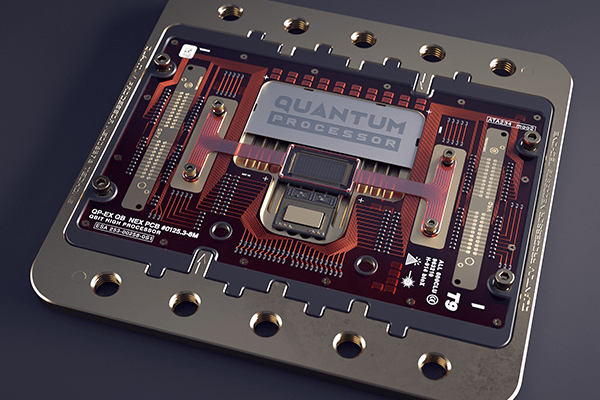Quantum
As the world’s innovation hub, California’s strong existing presence in precision manufacturing, semiconductors and advanced materials positions the state to lead in the emerging field of quantum. The state is home to 2 national quantum foundries and 4 of the top 10 quantum universities in the U.S., producing the nation’s top quantum talent. Public and private partners are opening shared labs, expanding access, and helping move discoveries from the lab to real-world pilots in computing, sensing, networking, and materials. The result: a connected ecosystem where innovators can go from first experiment to production hardware—without ever leaving California.
In October 2025, Governor Newsom signed legislation and announced new funding to propel the state’s quantum industry. Under the bill, GO-Biz will publish a strategic framework, aligned with the state’s Economic Blueprint, helping to ensure the state continues to produce a strong talent pipeline, foster new research and development, and create opportunities for the technology of the future to grow in regions throughout the state.

Quantum California
Quantum California is a new statewide public–private initiative under California Jobs First that brings universities, national labs, companies, investors, and policymakers together to strengthen California’s position as a global hub for quantum. It spotlights California’s strengths—world-class research, shared facilities, and a deep talent pipeline—and connects people and projects across quantum computing, sensing, networking, and materials & devices. Through engagement and a statewide steering committee, Quantum California will align partners, showcase opportunities, and lay the groundwork for a statewide strategy and job-creation roadmap for quantum.
Advantages

Innovation Ecosystem
California’s innovation ecosystem is anchored by an unmatched cluster of research facilities and national labs—Lawrence Berkeley, Lawrence Livermore, SLAC, and NASA JPL—plus major sites like Sandia/CA and NASA Ames—giving companies access to foundry-grade fabrication, cryogenics, and space-qualification testbeds. California has the most Federally Funded Research and Development Centers (FFRDCs) of any state. It is also the only state that hosts both a U.S. Department of Energy National Quantum Information Science Research Center and an NSF quantum center: LBNL leads the Quantum Systems Accelerator, and UC Berkeley leads the NSF Quantum Leap Challenge Institute for Quantum Computation. California also co-anchors Q-NEXT’s national quantum foundry at SLAC’s Detector Microfabrication Facility, the NSF Quantum Foundry at UC Santa Barbara, and national assets at universities such as USC, Caltech, Stanford, and more.

Education and Workforce
California powers quantum talent at scale—uniting community colleges, 33 public university campuses (University of California and California State University), private institutes like Caltech, Stanford, and USC, and the nation’s largest concentration of federally funded research and development centers (FFRDCs—the most of any U.S. state), allowing students to move straight from classrooms to cleanrooms. With engineers, physicists, and computer scientists graduating by the thousands and community colleges supplying technician pathways, the state turns curiosity into careers across cryogenics, photonics, control electronics, software, and systems integration. Employers tap statewide upskilling programs, creating a pipeline ready to staff everything from quantum prototypes to factory-scale quantum manufacturing and deployment.

Supply Chain and Manufacturing
California anchors the quantum hardware stack end-to-end. It is the nation’s leading producer of critical minerals—accounting for ~15% of global rare-earth supply, over one-third of global boron supply, and multiple other critical minerals—with 30+ active projects that secure inputs for magnets, photonics, and advanced electronics. The state also leads U.S. semiconductors and microelectronics, ranking #1 for semiconductor manufacturing establishments (627) and jobs (63,251), and shipping $10.2B in annual exports. Across the middle of the stack, a statewide network of nanofabrication and cryogenic test facilities supports wafer-scale integrated photonics and low-temperature device validation thus giving companies in-state photonics and cryo capacity to move from prototype to production.
Initiatives & Resources

Incentives for Quantum
If your quantum business is considering expanding or relocating to California, our office provides no-cost, confidential services for incentive and grant navigation. Our team of business consultants will guide you through the available tax credits, grants, and financing assistance options that are available to you.

California Jobs First
California Jobs First is a statewide economic development initiative that invests in key sectors to drive sustainable economic growth, innovation, and access to good-paying jobs. Quantum is noted as a high-tech sector and a key driver of the state’s economy.
References
1. Quantum skills covers a broad range of quantum and related technologies, including theoretical foundations (quantum mechanics, information theory, algorithms), computing frameworks and programming languages Source: Lightcast datarun 2025.4, accessed 10/21/2025
2. Research and Development in the Physical, Engineering, and Life Sciences (except Nanotechnology and Biotechnology) industry (NAICS 541715); used as a proxy industry that likely includes firms performing current quantum research – Source: Lightcast datarun 2025.4, accessed 10/21/2025
3. All Nobel Prizes in Physics. NobelPrize.org. Nobel Prize Outreach 2025. Tue. 4 Nov 2025

